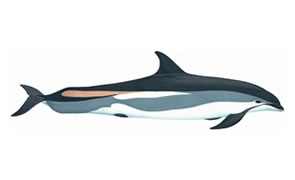Species Index


Key Facts
Length: Up to 2.8 metresRange: Cool temperate and subarctic waters of the North Atlantic
Threats: Entanglement in fishing gear, pollution, habitat degradation
Diet: Variety of fish, squid and shrimp
Atlantic White-sided Dolphin
Latin: Lagenorhynchus acutus
Gaelic: Deilf-chliathaich-ghil
Physical Description
The Atlantic white-sided dolphin has a very distinctive colour pattern, making it fairly easy to identify. The upper surface including the tall, falcate dorsal fin is dark grey. A band of light grey stretches from the eye to the tail, broken only by a flash of white in the middle of the flanks, and a blaze of yellow towards the tail; the belly and lower jaw are white. These zones of colour are sharply delineated. This is a robust-bodied dolphin with a small head and a short, inconspicuous beak. When fully grown, they can measure between 2.4 to 2.8 metres and weigh over 230 kg. Life expectancy is possibly about 27 years.
Habitat and Distribution
The Atlantic white-sided dolphin has a fairly narrow distribution in the cool temperate and subarctic waters of the North Atlantic. They prefer the continental shelf regions west of the Outer Hebrides, and although they tend to move closer to the coast throughout Hebridean waters during summer months, they are rarely seen within the Continental Shelf in the Hebrides.
Behaviour
In the waters off the west coast of Scotland, Atlantic white-sided dolphins have been seen in social groups of two to 30 animals, whilst larger aggregations of several hundred individuals are seen in other areas. Mixed schools of white-sided and white-beaked dolphins reportedly occur in the North Sea. These dolphins are fast swimmers, display acrobatic leaps, and will often approach vessels to bow ride.
Food and Foraging
The major prey items of the Atlantic white-sided dolphin are herring, cod and squid, but they consume a wide variety of other prey such as shrimp, mackerel and sandeels. They are sometimes seen co-operatively herding schooling fish against the surface. They have up to 78 pairs of teeth that are used to catch but not chew their prey.
Status and Conservation
The total global population of Atlantic white-sided dolphins is estimated at 200,000 to 300,000 individuals. Due to the offshore distribution of this species, they may be less exposed to the threats of pollution and disturbance than more coastally distributed species. Considerable numbers, however, continue to become entangled and drown in gill and trawl nets including those operating off south-western Ireland. Atlantic white-sided dolphins are protected under UK and EU law, principally under Schedule 5 of the Wildlife and Countryside Act 1981, the Nature Conservation (Scotland) Act 2004 and by the 1992 EU Habitats and Species Directive.





